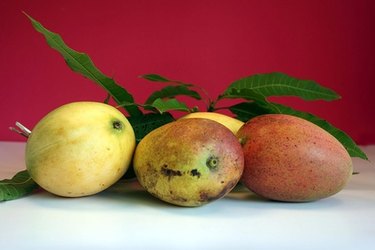Things You'll Need
Water
Mulch
Frost blanket
Stakes or concrete blocks
Canvas
Stakes
Scissors or knife
Plant ties

Mangoes are among the most cold-sensitive of fruit trees and grow best in subtropical and tropical climates. Cold winds cause the fruit to crack and spoil. Mango leaves and twigs begin to suffer serious damage at temperature below 30 degrees F. If your USDA plant hardiness zone is Zone 6 or lower, it's wise to plant mango trees in containers so they can be brought indoors for the winter. To the south of Zone 6, take precautions against winter chill and the occasional frost.
Step 1
Plant mango trees in a sheltered area, near a house or fence. Winds, particularly cold winds, can cause mango fruits to drop before they are ripe.
Video of the Day
Step 2
Water mango trees once a week starting in the fall and continuing through the winter to keep the tree healthy and vigorous. Cold temperatures can cause a tree to dehydrate quickly, making frost damage more severe. Spread a 4- to 5-inch ring of mulch, 8 inches from the trunk and extending out to the drip line of the branches to hold moisture and warmth in the soil.
Step 3
Spread a frost blanket over the canopy of the tree the night before frost is predicted. Stake the edges to the ground, or weight them with concrete blocks. The earth underneath will release heat into the enclosure overnight, keeping the tree warm.
Step 4
Erect a windbreak around the mango tree if winter winds are cold and consistent and the mango is in an unsheltered area. Pound tall stakes into the ground in a circle 3 to 5 feet from the trunk. Cover the stakes with canvas to form a screen. Cut holes in the canvas near the stakes. Poke plant ties through the holes and twist to secure the cloth to the stakes.
Tip
If you have to use a plastic frost blanket, do not allow it to make contact with foliage. Remove it immediately in the morning, before sun can make the interior of the enclosure too hot for the tree.
Warning
Don't plant mango trees outdoors if you live in an area that gets snow in winter. Plant them in containers and bring them indoors each fall.
Video of the Day